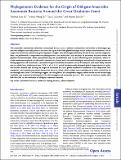Files in this item
Phylogenomic evidence for the origin of obligately anaerobic anammox bacteria around the great oxidation event
Item metadata
| dc.contributor.author | Liao, Tianhua | |
| dc.contributor.author | Wang, Sishuo | |
| dc.contributor.author | Stüeken, Eva E | |
| dc.contributor.author | Luo, Haiwei | |
| dc.date.accessioned | 2022-08-22T11:30:16Z | |
| dc.date.available | 2022-08-22T11:30:16Z | |
| dc.date.issued | 2022-08-03 | |
| dc.identifier | 280850089 | |
| dc.identifier | 366fa76a-b5c5-4dcf-8539-f8bf214f1c01 | |
| dc.identifier | 000841939800002 | |
| dc.identifier | 85136910929 | |
| dc.identifier.citation | Liao , T , Wang , S , Stüeken , E E & Luo , H 2022 , ' Phylogenomic evidence for the origin of obligately anaerobic anammox bacteria around the great oxidation event ' , Molecular Biology and Evolution , vol. 39 , no. 8 , msac170 . https://doi.org/10.1093/molbev/msac170 | en |
| dc.identifier.issn | 0737-4038 | |
| dc.identifier.other | Jisc: 523746 | |
| dc.identifier.other | ORCID: /0000-0001-6861-2490/work/117211326 | |
| dc.identifier.uri | https://hdl.handle.net/10023/25870 | |
| dc.description | Funding: This work is funded by the National Science Foundation of China (92051113), the Hong Kong Research Grants Council Area of Excellence Scheme (AoE/M-403/16), the Direct Grant of CUHK (4053495), the Hong Kong Research Grants Council (RGC) General Research Fund (GRF) (14110820), and The CUHK Impact Postdoctoral Fellowship Scheme to (S. W.). | en |
| dc.description.abstract | The anaerobic ammonium oxidation (anammox) bacteria can transform ammonium and nitrite to dinitrogen gas, and this obligate anaerobic process accounts for up to half of the global nitrogen loss in surface environments. Yet its origin and evolution, which may give important insights into the biogeochemistry of early Earth, remains enigmatic. Here, we performed comprehensive phylogenomic and molecular clock analysis of anammox bacteria within the phylum Planctomycetes. After accommodating the uncertainties and factors influencing time estimates, which includes implementing both a traditional cyanobacteria-based and a recently developed mitochondria-based molecular dating approach, we estimated a consistent origin of anammox bacteria at early Proterozoic and most likely around the so-called Great Oxidation Event (GOE; 2.32 to 2.5 billion years ago [Ga]) which fundamentally changed global biogeochemical cycles. We further showed that during the origin of anammox bacteria, genes involved in oxidative stress adaptation, bioenergetics and anammox granules formation were recruited, which might have contributed to their survival on an increasingly oxic Earth. Our findings suggest the rising levels of atmospheric oxygen, which made nitrite increasingly available, was a potential driving force for the emergence of anammox bacteria. This is one of the first studies that link the GOE to the evolution of obligate anaerobic bacteria. | |
| dc.format.extent | 1177163 | |
| dc.language.iso | eng | |
| dc.relation.ispartof | Molecular Biology and Evolution | en |
| dc.subject | Anammox bacteria | en |
| dc.subject | Molecular dating analysis | en |
| dc.subject | Planctomycetes | en |
| dc.subject | GE Environmental Sciences | en |
| dc.subject | QH301 Biology | en |
| dc.subject | DAS | en |
| dc.subject.lcc | GE | en |
| dc.subject.lcc | QH301 | en |
| dc.title | Phylogenomic evidence for the origin of obligately anaerobic anammox bacteria around the great oxidation event | en |
| dc.type | Journal article | en |
| dc.contributor.institution | University of St Andrews. School of Earth & Environmental Sciences | en |
| dc.contributor.institution | University of St Andrews. St Andrews Centre for Exoplanet Science | en |
| dc.identifier.doi | 10.1093/molbev/msac170 | |
| dc.description.status | Peer reviewed | en |
This item appears in the following Collection(s)
Items in the St Andrews Research Repository are protected by copyright, with all rights reserved, unless otherwise indicated.

